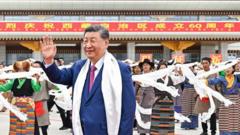In a rare visit to Tibet, Chinese President Xi Jinping addressed around 20,000 attendees in Lhasa to commemorate the 60th anniversary of the region's establishment as an autonomous area following its annexation by Beijing. This marks only Xi's second trip as president to the tightly monitored region, where he championed local leadership’s efforts against separatism, acknowledging the ongoing Tibetan resistance to Chinese governance.
Xi, who appeared at an altitude that poses health risks given his age, highlighted the need for political stability, social coherence, and religious unity as prerequisites for governing Tibet. Notably absent from Xi's remarks was any mention of the Dalai Lama, the exiled Tibetan spiritual leader, whose influence in Tibetan identity and culture remains significant.
The timing of Xi's visit comes shortly after the Dalai Lama declared that his office, rather than China, will be responsible for selecting his successor, a claim Chinese officials contest. Despite Beijing’s assertions of improved living standards in Tibet, criticisms persist regarding human rights violations and the suppression of Tibetan identity, driven by the Chinese Communist Party's policies.
Xi's visit was prominently featured across state media, depicting his interactions with local culture—celebrated by traditional dancers and enthusiastic crowds. In discussions with CCP leaders, the President stressed fostering economic ties, cultural exchanges, and the implementation of a standardized national language to advance unity.
Moreover, Xi's tour coincides with the launch of construction on the world’s largest dam on the Yarlung Tsangpo river, a project that Beijing argues will enhance local prosperity but raises concerns over environmental implications and transboundary water control.
The CCP's strategies in Tibet also include reforms in education, mandating that Tibetan children attend state-run schools and learn Mandarin, alongside calls for oversight on religious practices to align Buddhism with socialist ideals. As China's grip on Tibet endures, the tension between cultural preservation and governmental control continues to provoke debates both within Tibet and internationally.
Xi, who appeared at an altitude that poses health risks given his age, highlighted the need for political stability, social coherence, and religious unity as prerequisites for governing Tibet. Notably absent from Xi's remarks was any mention of the Dalai Lama, the exiled Tibetan spiritual leader, whose influence in Tibetan identity and culture remains significant.
The timing of Xi's visit comes shortly after the Dalai Lama declared that his office, rather than China, will be responsible for selecting his successor, a claim Chinese officials contest. Despite Beijing’s assertions of improved living standards in Tibet, criticisms persist regarding human rights violations and the suppression of Tibetan identity, driven by the Chinese Communist Party's policies.
Xi's visit was prominently featured across state media, depicting his interactions with local culture—celebrated by traditional dancers and enthusiastic crowds. In discussions with CCP leaders, the President stressed fostering economic ties, cultural exchanges, and the implementation of a standardized national language to advance unity.
Moreover, Xi's tour coincides with the launch of construction on the world’s largest dam on the Yarlung Tsangpo river, a project that Beijing argues will enhance local prosperity but raises concerns over environmental implications and transboundary water control.
The CCP's strategies in Tibet also include reforms in education, mandating that Tibetan children attend state-run schools and learn Mandarin, alongside calls for oversight on religious practices to align Buddhism with socialist ideals. As China's grip on Tibet endures, the tension between cultural preservation and governmental control continues to provoke debates both within Tibet and internationally.


















